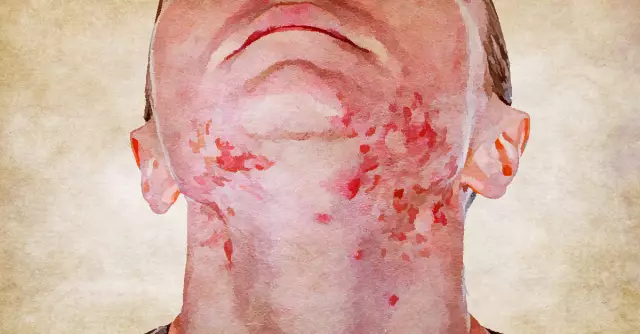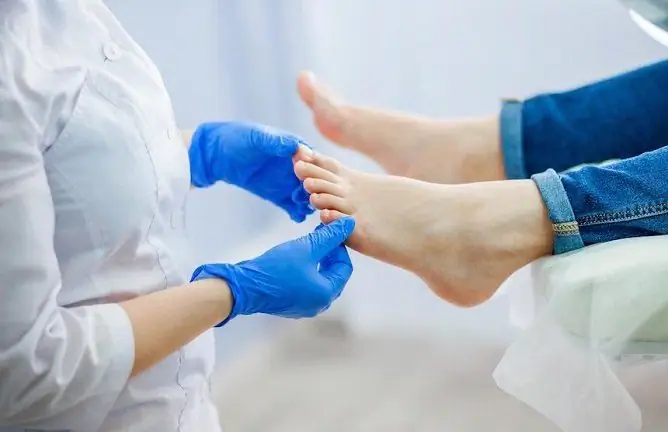- Author Rachel Wainwright [email protected].
- Public 2023-12-15 07:39.
- Last modified 2025-11-02 20:14.
Sweat glands

Sweat glands are small, unbranched, tubular structures whose task in humans and other mammals is to produce and release sweat onto the skin surface.
The human body has about 2-2.5 million sweat glands located unevenly throughout the body: their density per square centimeter of skin can vary from 45-400 elements. The greatest density of sweat glands is observed on the soles of the feet, the back surfaces of the hands and feet, and the skin of the palms. In particular, sweat structures are not found on the glans penis and foreskin in men, as well as on the inner side of the labia majora and labia minora, the clitoris in women.
The structure of the sweat glands is quite simple: they consist of secretory glomeruli, which lie at different depths in the subcutaneous fat and deeper layers of the dermis and excretory ducts.
Sweat gland functions
There are two types of sweat glands that are fundamentally different from each other:
- Eccrine (exocrine) sweat glands;
- Apocrine sweat glands.
The eccrine or small sweat glands are 99% water, 1% of the structures contain organic and inorganic substances that give the skin surface an acidic reaction. The total amount of sweat produced by the eccrine glands is regulated by the hormonal and nervous system and depends on the density of the sweat glands and the intensity of their work. On average, a person's exocrine sweat glands secrete about 250-800 ml of sweat per day.
Eccrine sweat glands help maintain a stable body temperature, as well as remove toxins and harmful substances from the body. They are responsible for creating a hydro-acid-lipid film on the surface of the skin - a natural moisturizing factor that prevents the skin from drying out.
Apocrine sweat glands are located mainly in the armpits, on the wings of the nose, eyelids, in the genital area. They are not involved in the processes of thermoregulation, however, they are able to respond to stress with the help of a viscous secretion with a specific odor, which is formed due to the fusion of fat and cholesterol. The function of this type of sweat glands is to regulate the saprophytic microflora of the epidermis, preventing the occurrence of skin inflammation.
It is believed that it is the secret of the apocrine sweat glands that stimulates the representatives of the opposite sex - therefore they are also called the glands of the genital odor.
The peak of the activity of the work of the apocrine sweat glands is observed in adolescence, and as a person grows up, it weakens.
There are several functions of the human sweat glands. These include:
- Sweating or the implementation of the protective function of the sweat gland;
- Thermoregulatory sweating. Achieved by evaporation of sweat from the surface of the skin;
- Psychogenic sweating. It has fundamental differences from the thermoregulatory one, since it occurs only in the case of mental stress and after the elimination of the stimulus, it immediately stops. As a rule, it has a local character, forming on the palms, soles of the feet, armpits, and some areas of the face;
- In addition, the sweat glands support the excretory function of the body, freeing it from a number of toxic metabolic products.
Sweat gland diseases
Most of the pathologies associated with the work of the sweat glands are due to the presence of concomitant diseases in the human body. There are such violations of this body as:
- Anhidrosis;
- Hyperhidrosis;
- Oligohydrosis;
- Osmidrosis;
- Hydradenitis.
Anhidrosis - lack of perspiration. This disease is caused either by insufficient activity of the sweat glands, or by inadequate development of nerve elements. Anhidrosis is one of the syndromes of acute lung cancer.
Oligohydrosis is a disease that has common roots with anhidrosis: it is characterized by insufficient sweating and manifests itself, most often, in old age due to skin aging.
Hyperhidrosis is a disease of increased sweating. It has general and localized views. Generalized hyperhidrosis is manifested by uncontrolled sweating over the entire surface of the body; localized hyperhidrosis is characterized by increased sweating of certain parts of the body - armpits, palms, soles of the feet. Hyperhidrosis is observed in people suffering from Graves' disease, tuberculosis, neurasthenia, psoriasis and neurodermatitis.
Osmidrosis is a disease characterized by an unpleasant odor caused by the decomposition of sweat under the influence of certain bacteria. Osmidrosis can be caused by endocrine disorders, excessive sweating, diaper rash, and poor personal hygiene.
Hydradenitis (inflammation of the sweat glands) is a disease that is popularly called "bitch udder". It is characterized by purulent inflammation of the sweat glands in the armpits, labia and anus. The symptoms of hydradenitis are as follows: a small and painful seal appears in the subcutaneous fat layer, which further increases. The skin in the affected area turns red, swells, a tumor appears, which, when opened, secretes a significant amount of pus.
The causes of hydradenitis can be hormonal disorders of the body (especially during menopause), as well as blockage of the sweat gland caused by diaper rash, abrasions, bacterial infection (streptococci, staphylococci), frequent use of antiperspirants, and insufficient skin hygiene.
The obstruction of the sweat gland, which is undesirable for the body, can be prevented by strengthening the immune system, a normal drinking regimen, adherence to personal hygiene, and the rejection of antiperspirants containing aluminum and zinc in favor of conventional deodorants.
Sweat gland removal

The removal of the sweat glands is understood as a surgical operation designed to stabilize the process of sweating in people suffering from hyperhidrosis.
There are several methods of surgical treatment of hyperhidrosis:
- Endoscopic sympathectomy. This procedure consists in the introduction of a tube with a video camera through a small puncture on the back or chest of a person, with the help of which the surgeon identifies the area "guilty" of increased sweating and cuts the corresponding sympathetic trunk;
- Sweat gland liposuction. Removal of sweat glands is carried out by introducing a cannula into the subcutaneous fat - a hollow needle, which, as it were, sucks out the sweat glands;
- Curettage. In the area of increased sweating, a small incision is made, after which, under the influence of local anesthesia, the sweat glands are scraped out with the help of special instruments.
Removal of sweat glands is a radical method of solving the problem of increased sweating, the result of which lasts for life.
Found a mistake in the text? Select it and press Ctrl + Enter.






